The use of medicinal tree, shrub, and plant products as a health resource is long-established on the continent of Africa. The continued reliance on such medicinal material and the dominance of its collection from natural populations of species has implications for sustainable use. For many species there is a lack of research on the trade of medicinal material and especially, species-specific data relating to the population, distribution, uses, market prospects, and potential for cultivation. The genus Warburgia Engl. includes four tree species found throughout eastern and southern Africa that are used for their medicinal properties to treat numerous human and livestock diseases. This study was undertaken to assess the supply chain for Warburgia in Kenya through market surveys using questionnaires in the three most populous cities: Nairobi, Kisumu, and Mombasa. Findings from this study indicate that the supply of Warburgia has declined in the last two years and that traders engage in unsustainable practices for addressing supply deficits. These include substitution of species or sourcing species material from different geographical locations. Such strategies can have implications for human and land health. Regional movement of Warburgia for trade is occurring, as it is sourced in Tanzania for trade in Kenyan urban markets. This movement of material indicates a high demand for Warburgia and implies extraneous pressure on available natural resources. The reliance and use of the bark and roots in the markets is a further threat to the use, and alternative, less destructive harvesting strategies should be developed
DOI:
https://doi.org/10.17348/era.12.0.671-683
Altmetric score:
Dimensions Citation Count:























